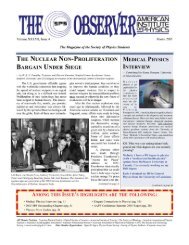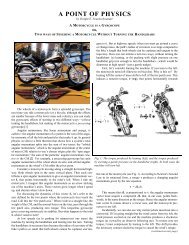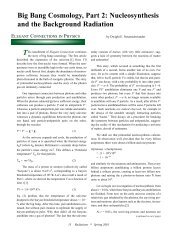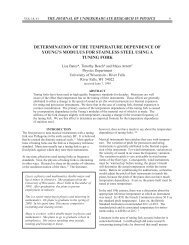Elegant Connections in Physics: Quantized Angular Momentum, 'g ...
Elegant Connections in Physics: Quantized Angular Momentum, 'g ...
Elegant Connections in Physics: Quantized Angular Momentum, 'g ...
Create successful ePaper yourself
Turn your PDF publications into a flip-book with our unique Google optimized e-Paper software.
χ = u χ + + v χ − (81)<br />
The coefficients u and v tell us, through |u| 2 and |v| 2 , the probabilities<br />
that the electron will be found to have sp<strong>in</strong> up or sp<strong>in</strong> down<br />
respectively. These probabilities are measured by count<strong>in</strong>g the fraction<br />
of particles, each <strong>in</strong> sp<strong>in</strong> state χ, that, when the sp<strong>in</strong> is measured,<br />
pops up as hav<strong>in</strong>g sp<strong>in</strong> up or sp<strong>in</strong> down. This state χ evolves<br />
<strong>in</strong> time accord<strong>in</strong>g to the Schröd<strong>in</strong>ger equation,<br />
H’ χ = (−\/i) ∂χ/∂t . (82)<br />
Split <strong>in</strong>to its two components, and temporarily lett<strong>in</strong>g ε denote<br />
−½\ g o (q/2m) for brevity, this matrix equation becomes the pair of<br />
equations<br />
εu = (−\/i) ∂u/∂t<br />
and<br />
εv = (+\/i) ∂v/∂t<br />
with solutions<br />
u(t) = u(0) e −iεt/\<br />
and<br />
v(t) = v(0) e iεt/\<br />
(83a)<br />
(83b)<br />
(84a)<br />
(84b)<br />
Because the electron when hit with a magnetic field must l<strong>in</strong>e up <strong>in</strong>to<br />
either the sp<strong>in</strong>-up state or the sp<strong>in</strong>-down state, at any time the probabilities<br />
sum to unity,<br />
1 = |u| 2 + |v| 2 (85)<br />
so that we can always write<br />
u(0) = cosδ<br />
and<br />
v(0) = s<strong>in</strong>δ<br />
(86a)<br />
(86b)<br />
for some real number δ. How does this phase angle δ for the sp<strong>in</strong> state<br />
relate to the angle θ <strong>in</strong> physical space that the sp<strong>in</strong> vector makes with<br />
the magnetic field B? For the classical dipole, θ is determ<strong>in</strong>ed from<br />
S z accord<strong>in</strong>g to<br />
S z = |S| cosθ (87)<br />
where the classical |S| can be any non-negative value from the cont<strong>in</strong>uum<br />
that we want (it does not have to be some <strong>in</strong>teger multiple of<br />
½\). Let’s calculate the expectation value of S z for quantized sp<strong>in</strong>.<br />
Here’s its physical situation: we have an ensemble of electrons, each<br />
carefully placed somehow <strong>in</strong> the state χ, the same χ for each electron<br />
<strong>in</strong> the ensemble. We hit each electron with the magnetic field and<br />
measure whether it aligns itself “sp<strong>in</strong> up” or “sp<strong>in</strong> down,” and collect<br />
statistics on the results. The numbers |u| 2 = cos 2 δ and |v| 2 = s<strong>in</strong> 2 δ will<br />
equal the fraction of electrons that have sp<strong>in</strong> up and sp<strong>in</strong> down<br />
respectively, if good agreement exists between theory and experiment<br />
(it does). A moment’s reflection on visualiz<strong>in</strong>g the physical situation<br />
suggests that the average value of S z for the ensemble will be 0 if half<br />
of the electrons have sp<strong>in</strong> up and the other half have sp<strong>in</strong> down, <strong>in</strong><br />
which case δ = π/4; yet for a classical macroscopic dipole with zero<br />
S z we would have θ = π/2. Let’s see if such a correlation arises <strong>in</strong> the<br />
theory.<br />
We must calculate the expectation value of S z ,<br />
^S z & = χ † S z χ<br />
= ½\ χ † σ z χ (88)<br />
where χ † denotes the row matrix obta<strong>in</strong>ed from the column matrix χ<br />
by transpos<strong>in</strong>g the latter and tak<strong>in</strong>g its complex conjugate. Carry<strong>in</strong>g<br />
out the matrix multiplication, we f<strong>in</strong>d<br />
^S z & = ½\ (cos 2 δ − s<strong>in</strong> 2 δ) (89)<br />
which might have been expected: the cos<strong>in</strong>e squared gives the probability<br />
that the electron has sp<strong>in</strong> up, and when it does have sp<strong>in</strong> up<br />
then S z equals ½\; and the s<strong>in</strong>e squared gives the probability that the<br />
electron has sp<strong>in</strong> down, <strong>in</strong> which case S z equals −½\. Thus<br />
^S z & = (probability for sp<strong>in</strong> up)(S z with sp<strong>in</strong> up)<br />
+ (probability for sp<strong>in</strong> down)(S z with sp<strong>in</strong> down).<br />
But notice the crucial m<strong>in</strong>us sign between the cos<strong>in</strong>e squared and<br />
s<strong>in</strong>e squared terms. It rem<strong>in</strong>ds us of the existence of a trig identity,<br />
cos 2 δ − s<strong>in</strong> 2 δ = cos(2δ) (90)<br />
and thus<br />
^S z & = ½\ cos(2δ) . (91)<br />
When we compare the quantum sp<strong>in</strong> state to the direction of the classical<br />
sp<strong>in</strong>, we see that the phase δ and the physical angle θ are related<br />
by<br />
δ = ½θ . (92)<br />
This phase δ of the sp<strong>in</strong> state is half the angle θ <strong>in</strong> physical space<br />
made by the sp<strong>in</strong> vector relative to the z-quantization axis! Such a<br />
result formalizes our anticipation: if half the electrons have sp<strong>in</strong> up<br />
and half have sp<strong>in</strong> down, then their respective probabilities are ½<br />
each, which requires δ = 45°; this means <strong>in</strong> turn that the ensemble of<br />
electrons behaves statistically like a s<strong>in</strong>gle classical magnetic dipole<br />
tipped over at θ = 90°, with zero z-component for the sp<strong>in</strong>.<br />
Curiously, this means that if we envision a sp<strong>in</strong> vector that we<br />
can rotate through any angle we want, when we start out at θ = 0 and<br />
rotate through 180° we convert a (classical) S z = +S <strong>in</strong>to S z = −S. Now<br />
keep on rotat<strong>in</strong>g the vector on around, past 180° on back to 360°. The<br />
classical sp<strong>in</strong> vector has been restored to its orig<strong>in</strong>al state (∆θ = 2π),<br />
but the quantum sp<strong>in</strong> phase δ has gone through only half a cycle (∆δ<br />
= π)! In other words, to restore the quantum state back to its orig<strong>in</strong>al<br />
value we have to rotate the sp<strong>in</strong> vector through 4π radians of physical<br />
space, two full revolutions![6]<br />
OK then, we have found the expectation value of S z ; <strong>in</strong> particular,<br />
<strong>in</strong> terms of the spatial angle θ,<br />
^S z & = ½\ cosθ . (93)<br />
S z is <strong>in</strong>dependent of time, so long as the magnetic field is static. But<br />
we recall that the x and y components of S precess around the cone;<br />
they are time-dependent, even <strong>in</strong> a static field. Let’s see if this <strong>in</strong>tuition<br />
stands up to explicit calculation. Straightforward matrix algebra<br />
gives<br />
PAGE 8






